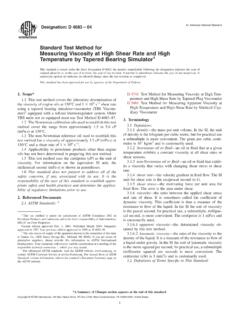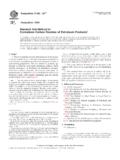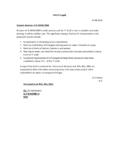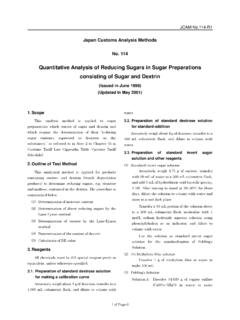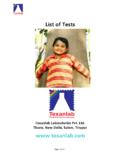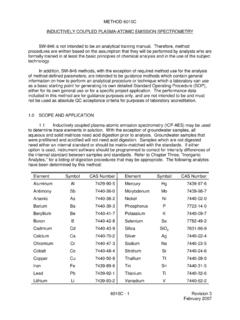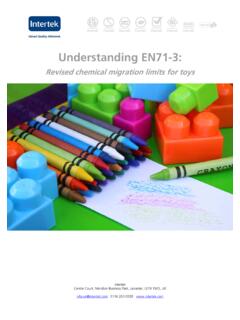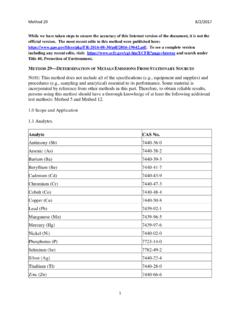Transcription of Standard Test Method for Water Using Volumetric …
1 Designation: E 203 01 Standard Test Method forWater Using Volumetric Karl Fischer Titration1 This Standard is issued under the fixed designation E 203; the number immediately following the designation indicates the year oforiginal adoption or, in the case of revision, the year of last revision. A number in parentheses indicates the year of last reapproval. Asuperscript epsilon (e) indicates an editorial change since the last revision or Standard has been approved for use by agencies of the Department of This test Method is intended as a general guide for theapplication of the Volumetric Karl Fischer (KF) titration fordetermining free Water and Water of hydration in most solid orliquid organic and inorganic compounds. This test Method isdesigned for use with automatic titration systems capable ofdetermining the KF titration end point amperometrically;however, a manual titration Method for determining the endpoint visually is included as Appendix X1.
2 Samples that aregaseous at room temperature are not covered (see AppendixX4). This test Method covers the use of both pyridine andpyridine-free KF reagents for determining Water by the volu-metric titration. Determination of Water Using KF coulometrictitration is not discussed. By proper choice of the sample size,KF reagent concentration and apparatus, this test Method issuitable for measurement of Water over a wide concentrationrange, that is, parts per million to pure Standard does not purport to address all of thesafety concerns, if any, associated with its use. It is theresponsibility of the user of this Standard to establish appro-priate safety and health practices and determine the applica-bility of regulatory limitations prior to warningsare given in and Review the current Material Safety Data Sheets (MSDS)for detailed information concerning toxicity, first aid proce-dures, and safety precautions for chemicals used in this Referenced A list of existing ASTM Karl Fischer methods , theirapplications to various products, and the sponsoring commit-tees is given in Appendix standards .
3 D 789 Test methods for Determination of Relative Viscos-ity, and Moisture Content of Polyamide (PA)2D 803 Test methods for Testing Tall Oil3D 890 Test Method for Water in Liquid Naval Stores3D 1123 Test methods for Water in Engine Coolant Concen-trate by the Karl Fischer Reagent Method4D 1152 Specification for Methanol (Methyl Alcohol)5D 1193 Specification for Reagent Water6D 1348 Test methods for Moisture in Cellulose3D 1364 Test Method for Water in Volatile Solvents (FischerReagent Titration Method )5D 1533 Test Method for Water in Insulating Liquids byCoulometric Karl Fischer Titration7D 1568 Test methods for Sampling and Chemical Analysisof Alkylbenzene Sulfonates8D 1631 Test Method for Water in Phenol and RelatedMaterials by the Iodine Reagent Method5D 2072 Test Method for Water in Fatty Nitrogen Com-pounds3D 2575 Method for Testing Polymerized Fatty Acids3D 3277 Test methods for Moisture Content of Oil-Impregnated Cellulosic Insulation7D 3401 Test methods for Water in Halogenated OrganicSolvents and Their Adixtures9D 4017 Test Method for Water in Paints and Paint Materialsby Karl Fischer Method10D 4377 Test Method for Water in Crude Oils by Potentio-metric Karl Fischer Titration11D 4672 Test methods for Polyurethane Raw Materials-Determination of Water Content of Polyols12D 4928 Test
4 methods for Water in Crude Oils by Coulom-etric Karl Fischer Titration131 This test Method is under the jurisdiction of ASTM Committee E15 onIndustrial and Specialty Chemicals and is the direct responsibility of on General edition approved Oct. 10, 2001. Published December 2001. Originallypublished as E 203 62 T. Last previous edition E 203 Book of ASTM standards , Vol Book of ASTM standards , Vol Book of ASTM standards , Vol Book of ASTM standards , Vol Book of ASTM standards , Vol Book of ASTM standards , Vol Book of ASTM standards , Vol Book of ASTM standards , Vol Book of ASTM standards , Vol Book of ASTM standards , Vol Book of ASTM standards , Vol Book of ASTM standards , Vol ASTM International, 100 Barr Harbor Drive, PO Box C700, West Conshohocken, PA 19428-2959, United 5460 Test Method for Rubber Compounding Materials- Water in Rubber Additives14D 5530 Test Method for Total Moisture of Hazardous WasteFuel by Karl Fischer Titrimetry15D 6304 Test Method for Determination of Water in Petro-leum Products, Lubricating Oils.
5 And Additives by Coulo-metric Karl Fisher Titration8E 180 Practice for Determining the Precision of ASTMM ethods for Analysis and Testing of Industrial Chemicals9E 200 Practice for Preparation, Standardization, and Stor-age of Standard and Reagent Solutions for ChemicalAnalysis9E 1064 Test Method for Water in Organic Liquids byCoulometric Karl Fischer Titration93. Summary of Test The sample, containing a maximum of 100 mg of Water ,is dissolved or dispersed in a suitable liquid and titrated withKF reagent, which consists of iodine, sulfur dioxide, organicbase, and a solvent (typically an alcohol, such as methanol,ethylene glycol, or 2-methoxyethanol). The titration end pointis determined amperometrically with a platinum electrodewhich senses a sharp change in cell resistance when the iodineis reduced by sulfur dioxide in the presence of Water .
6 (Warning KF reagent contains four toxic compounds,namely, iodine, sulfur dioxide, pyridine or other organic bases,and methanol or glycol ether. The reagent should be dispensedin a well-ventilated area. Care must be exercised to avoidinhalation of the reagent or direct contact of the reagent withthe skin.) The general equation to this reaction is as follows:H2O1I21SO21R8OH13RN.~RNH!SO4R812 ~RNH!I(1)where:RN= an organic base such as pyridine, andR8OH= Significance and Titration techniques Using KF reagent are one of themost widely used for the determination of Although the Volumetric KF titration can determine lowlevels of Water , it is generally accepted that coulometric KFtitrations (see Test Method E 1064) are more accurate forroutine determination of very low levels of Water . As a generalrule, if samples routinely contain Water concentrations of 500ppm or less, the coulometric technique should be Applications can be subdivided into two sections: (1)organic and inorganic compounds, in which Water may bedetermined directly, and (2) compounds, in which Water cannotbe determined directly, but in which interferences may beeliminated by suitable chemical reactions or modifications ofthe procedure.
7 Further discussion of interferences is includedin Section 5 and Appendix Water can be determined directly in the presence of thefollowing types of compounds:Organic CompoundsAcetalsEthersAcids (Note 1)HalidesAcyl halidesHydrocarbons (saturated and unsaturated)AlcoholsKetones, stable (Note 4)Aldehydes, stable (Note 2)NitrilesAmidesOrthoestersAmines, weak (Note 3)Peroxides (hydro, dialkyl)AnhydridesSulfidesDisulfidesThio cyanatesEstersThioestersInorganic CompoundsAcids (Note 5)Cupric oxideAcid oxides (Note 6)DesiccantsAluminum oxidesHydrazine sulfateAnhydridesSalts of organic and inorganic acids (Note 6)Barium dioxideCalcium carbonateNOTE1 Some acids, such as formic, acetic, and adipic acid, are slowlyesterified. For high accuracy with pyridine-based reagents, use 30 to 50 %pyridine in methanol as the solvent. When Using pyridine-free reagents,commercially available buffer solutions16can be added to the sample priorto titration.
8 With formic acid, it may be necessary to use methanol-freesolvents and titrants(1).17 NOTE2 Examples of stable aldehydes are formaldehyde, sugars,chloral, etc. Formaldehyde polymers contain Water as methylol combined Water is not titrated. Addition of an excess of NaOCH3inmethanol permits release and titration of this combined Water , afterapproximate neutralization of excess base with acetic acid (see Note 9).NOTE3 Weak amines are considered to be those withKbvalue< Examples of stable ketones are diisopropyl ketone, camphor,benzophenone, benzil, dibenzolacetone, Sulfuric acid up to a concentration of 92 % may be titrateddirectly; for higher concentrations see Note Compounds subject to oxidation-reduction reactions in aniodine-iodide system A number of substances and classes of compoundsinterfere in the determination of Water by this titrimetricmethod, complete descriptions of which are found in theliterature(2).
9 This interference is associated with condensationor oxidation-reduction Interferences of many classes of compounds can beeliminated by chemical reactions to form inert compoundsprior to titration. The following are in this category:Aldehydes and ketones, active (Note 7)Amines, strong (Note 8)Ammonia (Note 9)Ferric salts (Note 10)Hydrazine derivatives (Note 9)Hydroxylamine salts (Note 11)Mercaptans (Note 12)Sodium methylate (Note 9)Sulfuric acid (Note 13)Thioacids (Note 12)Thiourea (Note 12)NOTE7 This interference may be reduced by use of pyridine ratherthan methanol as solvent for the same or by the use of KF reagent andsolvent prepared with ethylene glycol monomethyl ether in place ofmethanol. For pyridine-free reagents, use ethylene glycol monomethyl-ether, ethylene glycol, benzyl alcohol or dimethylformamide in place of14 Annual Book of ASTM standards , Vol Book of ASTM standards , Vol Chemicals, 1324 Motor Parkway, Hauppauge, NY, 11788, Hydranaltbuffer has been found boldface numbers in parentheses refer to the list of references at the endof this test 2032the methanol solvent and use a methanol-free titrant(1).
10 The cyanhydrinreaction may be used to eliminate the interference(2).NOTE8 Strong amines are considered to be those withKbvalue> 5. Use salicylic acid-methanol solution (Section 7). Glacialacetic acid is applicable in certain Addition of acetic acid eliminates the Ferric fluoride does not interfere. Reaction with8-hydroxyquinoline is reported to eliminate this interference(3).NOTE11 With pyridine-based reagent, add1 MSO2in 1 + 1 pyridine-methanol or spent KF reagent. With pyridine-free reagents, the twocomponent reagent methods should be used and 1 mL of sulfuric acid isadded to the solvent prior to titration (Note 15).NOTE12 Olefin addition reaction eliminates interferences(2). Oxida-tion with neutral iodine solution eliminates the interference of mercaptans(4).NOTE13 Sulfuric acid, above 92 %. Add the sample (10 g) to a largeexcess of pyridine (35 mL), swirl to dissolve precipitate, and of 8 mL of 1 + 1 pyridine-dioxane/1 g of sample also issatisfactory, maintaining a homogeneous solution throughout the If there is a question of compounds listed in causingan interference, the recovery of spiked additions of Water to thesample matrix should be Many materials react stoichiometrically with KF re-agent.

